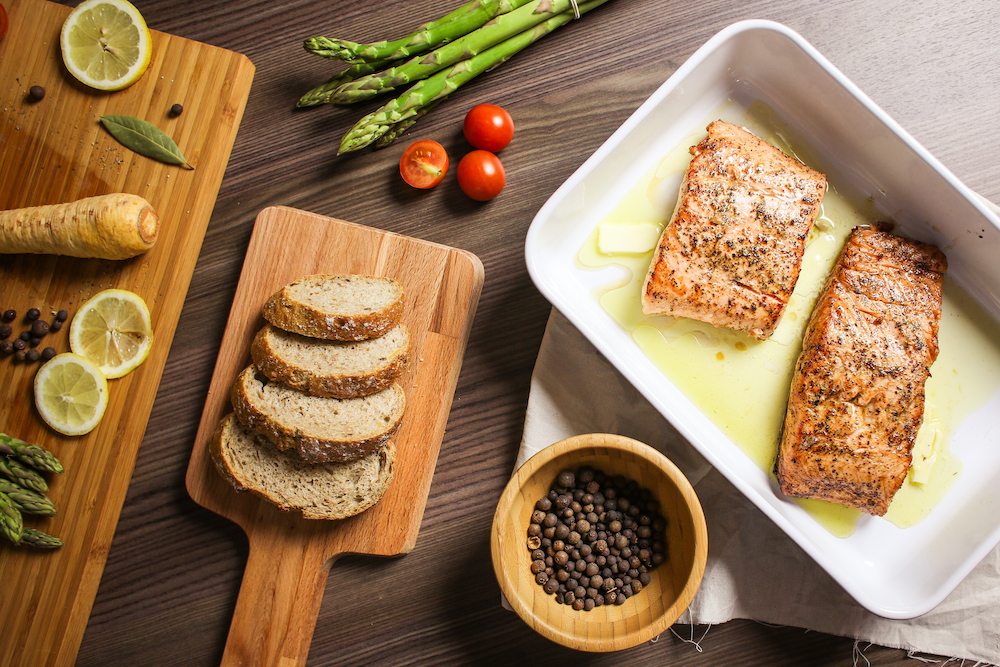Let me paint a picture for you. See if you can relate…
You’ve been recently diagnosed with IBS, or have been struggling with digestive upset for years and have decided to give the Low FODMAP diet a try. You hit the grocery store, Low FODMAP food list in hand, and come home to your kitchen with your haul of good-for-your-gut foods, ready to put your symptoms behind you with this new diet.
These are great first steps for tackling any new and overwhelming lifestyle change, but did you stop to consider how your environment will influence your success? Yes, that’s right, your kitchen environment!
When springtime rolls around, we hear a lot about spring cleaning our homes and detoxing our diets. It’s a great time to take stock of your life and your health. What’s working? What’s not? A new season offers a wonderful opportunity to let go of old habits and refocus on what’s right for your lifestyle and your body.
The truth is, the Low FODMAP diet is tough. Setting yourself up for success is so important, and this means evaluating your goals and what you need to overcome barriers. This is exactly why I created the CLAIRITY Program, to provide you with support as you embark on this difficult journey, and make it a little easier on you 😉
Today, we are lucky to have Registered Dietitian Jessica Cording here to tell us all about how to make the most of our kitchen space for achieving success on any new diet overhaul. Thanks for being here with us and for sharing Jessica!
Why You Should Detox Your Kitchen
For most people, the kitchen is an area in the home that gets a lot of traffic. It’s a central space that provides mental, physical, and emotional nourishment. It’s where we prepare—and often eat—meals and snacks, and for many families, it’s the place where everyone tends to gather. For these reasons, the state of this important space can have a huge impact on our eating habits. Research from the Cornell Food and Brand Lab showed that being in a chaotic kitchen with cluttered countertops may cause us to overeat or reach for more indulgent foods.
A turn of seasons is a great time to check-in; an especially important step if you’re in the earlier stages of getting a handle on dietary changes to manage a health condition such as IBS, diabetes, or celiac disease. Change takes time and often involves periods of trial and error, so be kind to yourself.
In this post, we’ll talk about ways to evaluate where you’re at in relation to your goals and how to clean up your kitchen. But first, we will tackle some strategies for hitting the reset button so you can continue on a feel-well path.
Start with a Lifestyle Review
Before you get started with your kitchen overhaul, spend some time journaling about what your health and wellness goals are. Having trouble getting started? Try asking yourself some of these questions:
- What in your life is supporting your goal? What’s not?
- What habits/foods make you feel well?
- What habits/foods make you feel unwell?
- What lifestyle changes have you made? Are there others you still want to make?
- What’s standing in the way of your making changes?
- What are some ways you can address those barriers?
You could also take a more free-form, less structured approach and jot down some notes about what’s going well and what you think could be better. For those things that aren’t working for you, what can you do about it? Are these things you should let go of, or things you can change your approach to?
Say you want to cook at home more to save money on gluten-free meals, but feel like your time is too limited. Brainstorm some realistic ways to make it happen. Perhaps you could try setting aside an hour or two for meal prepping on the weekends or dusting off your slow cooker so dinner is ready and waiting when you get home from work.
Turn Mistakes into Lessons
Conducting a lifestyle review might bring some habits or behaviours you’re not so happy with to the forefront, and that’s OK! Rather than beating yourself up for “mistakes” you may have made, look for the lessons that will help you moving forward. What did you learn and what do you want to do differently going forward? Maybe you learned the hard way this winter that a low-carb diet or vegan approach wasn’t for you. Acknowledge what you’ve learned, think about the whys, and move on.
For dietary changes that involve phases of elimination and reintroduction, such as the Low FODMAP diet, ask yourself if you have set up your environment for success in terms of eliminating triggers. On the flip side, maybe you’ve been eliminating and over-restricting for too long and it’s time to re-visit the challenge phases so can open up your diet and reintroduce some foods.
If you’ve been trying to get into a groove with a diet change—say you’re adjusting to a gluten-free diet—consider what comes easily and what you struggle with. Maybe swapping your morning bagel for gluten-free oats or a smoothie has been easy, but coming up with dinner ideas to fill the pasta void has been a challenge. How about branching out and trying some red lentils with seared scallops and your favorite greens? Swap out brown rice for quinoa or another gluten-free grain like millet or teff. Ever try socca pizza? Make a list or start a Pinterest board and collect a bunch of recipes that catch your eye.
How to Do a Kitchen Detox
Start by blocking off a few solid, uninterrupted hours in your schedule to get down to work instead of trying to squeeze it in between other tasks. Making sure you have all the cleaning and organizing supplies you need to get the job done before you start will also help you avoid disruptive last-minute trips to the store that can completely ruin your work flow! Next, designate a box or bag for things to donate, and another for things to ditch. If the thought of tackling your kitchen feels daunting, turn on your favorite music or download some podcasts you’ve been meaning to listen to to help get you motived and enjoy the process a little more. Last, divide your kitchen into several sections to keep you from feeling overwhelmed, and to give yourself a sense of accomplishment each time you complete a section.
Step 1: The Fridge
- Pull all items out of the fridge.
- Throw out expired and old food—or just those things you know you’ll never eat or that won’t support your goal.
- Wipe down the shelves. If you can rearrange them and want to change the height in different sections, this is a good time to do that.
- Pull out the drawers. Clean them and put them back in.
- Put the food back in neatly. You don’t have to put it exactly where it was before—take a moment to figure out where it feels like the most practical place for you. What you see when you first open your fridge is what you will reach for most. Take advantage of this and place healthy choices right up front, or foods that you need to use up quickly before they go bad!
- Check the temperature. Ideally, you want your fridge to be around 35 to 38˚F to keep food in the safe temperature zone (below 40 degrees) without freezing (32 degrees).
- Dust and wipe down the top of the fridge.
- Remove any magnets or papers from the fridge doors. Clean the fridge before hanging anything back up. Throw out any outdated invitations or any items you don’t want to look at every day. Surround yourself with words and images that make you feel happy and create positive vibes!
Step 2: The Freezer
- Pull out all food from freezer.
- Throw out any food that’s expired, old, or not appropriate for your needs—or that you know you won’t eat, like that leftover soup that’s been in there for a year. If you’re trying to reduce sugar intake, just toss that pint of ice cream into the trash so it won’t be tempting you.
- Wipe down shelves.
- Wash ice cube trays and put them back neatly.
- Check the temperature. Though 32 degrees is the point at which water freezers, to maintain frozen food safely for an extended period of time, the freezer temperature should ideally be 0˚F.
- Put all the food back in neatly.
Step 3: The Pantry
- Pull out all items.
- Throw out expired, stale or old food.
- Set aside unopened items that aren’t in line with your goals to donate or give away.
- Dust and wipe down shelves and any organizers.
- Dust tops of cabinets.
- Place items back into pantry or cabinets neatly.
- Wipe down doors and knobs.
Step 4: The Counters
- Remove clutter.
- Separate out things to throw away from things to donate.
- Wipe down countertops.
- Place items back neatly.
- Managing clutter is key, but it’s also important to think about whether the way you have things arranged makes you more efficient in the kitchen or not. Does that spoon rest have to be on the left side of the stove, or might it be more convenient if you put in on the right hand side?
- Consider investing in some organizers for your cabinets, counters, and kitchen sink to maintain a sense of order.
Step 5: The Restock
Now it’s time to go shopping! First, you need a list. Don’t be afraid to make it longer than your usual grocery list. Think of it as what you would buy if you were moving into a new home or returning from a long trip. Investing the time and energy to consider how your needs may have changed and what you want to eat more and less of in the coming months will likely save you the frustration of last-minute shopping trips or tossing things you bought because you were on autopilot.
Organize your list by food group to help keep your shopping trip (or online ordering process) organized. You can also clip coupons or scope out online deals, but be mindful that sometimes a sale can trick us into buying something we wouldn’t otherwise. If you’re not sure, ask yourself, “Would I buy this if it weren’t discounted?”
Grains and Legumes
Which grains are okay for you to eat? For example, if you’re adjusting to a gluten-free diet, put some gluten-free grains on the list that you already know you like, along with some others you’re curious about. If you’re experimenting with cutting grains out of your diet, think about some alternative ways to make meals satisfying without them. For example, cauliflower rice, spiralized vegetables, or spaghetti squash can be substituted. You can also explore alternatives to grain flours such as coconut flour, almond flour, and chickpea flour.
If beans, peas, and lentils are on your menu, stock some of your favourites, as these can be a convenient, cost-effective way to add fibre, protein, and other nutrients such as B-vitamins and iron to meals. Combine some cooked beans with veggies and add an egg on top, and you’ve got an easy, delicious dinner.
Proteins
Which protein foods work well for your body and your lifestyle? Do you feel better with animal proteins as part of your regular diet, or does your body respond best to plant sources? A balance of the two? Are there any particular protein foods that are hard for you to digest? For example, some may find red meat upsets their stomach while fish is much gentler. Seitan might be okay but tofu is a no-go. You’re the expert on you, so honour what your body tells you.
Whatever you choose, prioritize whole, minimally processed varieties. Consider where it makes sense for you and your budget to purchase organic, wild, and sustainable options. Also, go slow on stuff like bacon or other cured meats, which are often packed with sodium and have been associated with a number of health conditions. My best advice is to minimize your intake of processed meat products with lengthy ingredients lists full of hard-to-pronounce items – they aren’t doing your body any favours.
Fats
While fat is an important part of the diet, for individuals with conditions such as IBS, your needs may differ from recommendations for the general public. While you may have a family member or friend who can’t stop talking about how healthy this or that nut or oil is, tune out the noise and remind yourself it’s okay that you may need to consume less or be mindful to avoid certain types of fat in favour of others that don’t trigger symptoms.
For cooking, have at least one neutral-flavoured oil such as sunflower or canola oil, and maybe another more flavourful type like olive oil. If you’re avoiding dairy, coconut oil is a great alternative to butter. You could also try ghee, a clarified butter that is lactose-free.
Nuts and seeds can be problematic for people with gastrointestinal disorders like IBS, colitis, and Crohn’s, though some do well with particular varieties in small amounts, but not others. Flax, chia, and hemp seeds are some other foods that may or may not be appropriate for you. If you’re not sure, touch base with your doctor or a Registered Dietitian.
Dairy
Dairy is somewhat controversial, so this is definitely a case where it’s important to be honest with yourself about what works for you rather than getting hung up on whether your social media feed thinks it’s objectively “good” or “bad.” Some people may tolerate low-lactose foods like kefir and cheddar cheese, but need to avoid drinking milk or eating yogurt and soft cheeses. If dairy is an appropriate choice for you, look for unsweetened varieties of foods like yogurt, kefir, and cottage cheese.
Rather than stocking your freezer with frozen treats (dairy or non-dairy), how about making them a special-occasion food where you make a trip to the ice cream shop or grocery store?
Fruits and Veggies
Again, this is a place to tune in to those choices that are good for you. For example, if you’re on a Low FODMAP diet, familiarize yourself with high and low FODMAP fruits and veggies. Also take into account what’s in season. Frozen fruits and vegetables can be a healthful option—just go for the simple stuff without added sauces or seasonings. If you’re looking to purchase more organic foods, prioritize items from the “Dirty Dozen” list like leafy greens, strawberries, cucumbers, and peaches and buying non-organic from the “Clean Fifteen” list of foods like avocado, kiwi, and eggplant.
Herbs and Spices
Many herbs and spices have been noted for their healing properties. However, what is helpful for some conditions may not be suitable for others. For example, garlic has been noted for its heart-health benefits, but it’s not suitable for a Low FODMAP diet. Your doctor or dietitian is a great resource if you have questions. Maybe you’ve heard that turmeric or peppermint oil are helpful for IBS? AN expert in the area can provide some insight on whether it would be a good choice for you and how you might incorporate that into your diet.
Supplements
Since a lot of people keep supplements in their kitchen, spring-cleaning is a great time to reassess what you’re taking and why. If you were taking a particular vitamin or mineral to guard against risk of deficiency while you were on an elimination diet, or supplementing another nutrient to address a gap in your diet, ask yourself if you still need it. If you’re anticipating new diet changes in the season ahead or struggling with any symptoms you suspect may be tied to a lack of something on your plate, this is a great time make an appointment with your doctor to run some tests, draw labs, and screen for any potential need to add appropriate supplements.
Remember – YOU are the expert on you! Trust yourself to know what feels right and what doesn’t. Be compassionate towards yourself. Your needs can change over time and giving yourself the freedom to adapt is key to long-term wellness. Cheers to a healthy new season!





